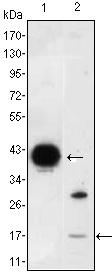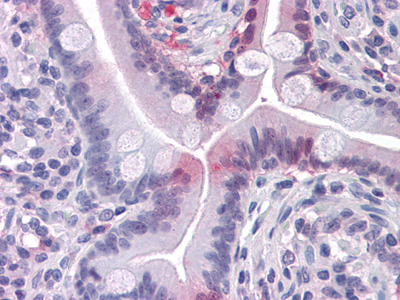I-FABP Monoclonal Antibody
- 货号:YM0352
- 应用:WB;IHC;IF;FCM;ELISA
- 种属:Human
- 简介:
- >>PPAR signaling pathway;>>Fat digestion and absorption
- 蛋白名称:
- Fatty acid-binding protein, intestinal
- 免疫原:
- Purified recombinant fragment of human I-FABP expressed in E. Coli.
- 特异性:
- I-FABP Monoclonal Antibody detects endogenous levels of I-FABP protein.
- 组成:
- Liquid in PBS containing 50% glycerol, 0.5% BSA and 0.02% sodium azide.
- 稀释:
- WB 1:500 - 1:2000. IHC 1:200 - 1:1000. IF 1:200 - 1:1000. Flow cytometry: 1:200 - 1:400. ELISA: 1:10000. Not yet tested in other applications.
- 纯化工艺:
- Affinity purification
- 储存:
- -15°C to -25°C/1 year(Do not lower than -25°C)
- 其他名称:
- FABP2;FABPI;Fatty acid-binding protein; intestinal;Fatty acid-binding protein 2;Intestinal-type fatty acid-binding protein;I-FABP
- 背景:
- The intracellular fatty acid-binding proteins (FABPs) belong to a multigene family with nearly twenty identified members. FABPs are divided into at least three distinct types, namely the hepatic-, intestinal- and cardiac-type. They form 14-15 kDa proteins and are thought to participate in the uptake, intracellular metabolism and/or transport of long-chain fatty acids. They may also be responsible in the modulation of cell growth and proliferation. Intestinal fatty acid-binding protein 2 gene contains four exons and is an abundant cytosolic protein in small intestine epithelial cells. This gene has a polymorphism at codon 54 that identified an alanine-encoding allele and a threonine-encoding allele. Thr-54 protein is associated with increased fat oxidation and insulin resistance. [provided by RefSeq, Jul 2008],
- 功能:
- domain:Forms a beta-barrel structure that accommodates the hydrophobic ligand in its interior.,function:FABP are thought to play a role in the intracellular transport of long-chain fatty acids and their acyl-CoA esters. FABP2 is probably involved in triglyceride-rich lipoprotein synthesis. Binds saturated long-chain fatty acids with a high affinity, but binds with a lower affinity to unsaturated long-chain fatty acids. FABP2 may also help maintain energy homeostasis by functioning as a lipid sensor.,induction:By EGF.,similarity:Belongs to the calycin superfamily. Fatty-acid binding protein (FABP) family.,tissue specificity:Expressed in the small intestine and at much lower levels in the large intestine. Highest expression levels in the jejunum.,
- 组织表达:
- Expressed in the small intestine and at much lower levels in the large intestine. Highest expression levels in the jejunum.

- Western Blot analysis using I-FABP Monoclonal Antibody against FABP2-hIgGFc transfected HEK293 (1) cell lysate and LOVO (2) cell lysate.

- Immunohistochemistry analysis of paraffin-embedded human Small Intestine tissues with AEC staining using I-FABP Monoclonal Antibody.

- Immunofluorescence analysis of 3T3-L1 cells using I-FABP Monoclonal Antibody (green). Blue: DRAQ5 fluorescent DNA dye. Red: Actin filaments have been labeled with Alexa Fluor-555 phalloidin.

- Flow cytometric analysis of LOVO cells using I-FABP Monoclonal Antibody (green) and negative control (purple).







